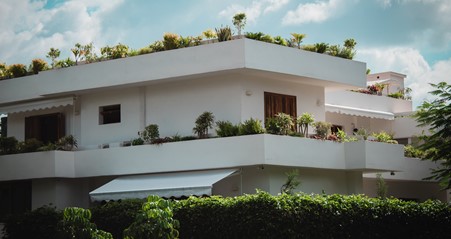What is an eco-friendly house?
An eco-friendly house is just what it sounds like – it’s an environmentally low-impact building with the use of materials and technology that make it more efficient and reduces its carbon footprint. Aiming for sustainability, an eco-friendly house may include extra thermal insulation than is normally required, heating from renewable resources, and good levels of daylight. Through this, the aim of the house is to reduce energy loss, especially as home energy makes up a huge contribution to global warming. A south-facing design is perfect for an eco-friendly house because of the added access to sunlight. Through this, the house can take the benefits of a passive solar gain, taking in more heat and securing it with its top-quality insulation and windows that limit heat transfer. Living gain can also generate a little heat, as well as added solar panels. A lot of eco-friendly houses also include heat recovery ventilation, which takes heat out of stale, damp air before venting it outside the house. The system then transfers this extracted heat to the fresh air coming into the house. There’re so many environmentally friendly building concepts like the ones described above that contribute to the efficiency of these types of houses.
Choose the right materials
Eco-friendly houses reduce the planet’s waste by using reusable and recyclable materials, timber and lime being just a couple of beneficial construction materials just to name a few. Of course, you’ll want to choose sustainable materials over materials that will contribute to harming the environment, including plastic. Timber is the main type of material used for eco-friendly houses. Timber is sourced from trees – which do not pollute the earth, absorb CO2 emissions, and gives out oxygen, creating a lot of great benefits for our environment and wildlife habitats. After construction, timber can even be reused so it doesn’t go to any waste. Secondly, lime, another building material commonly used for eco-friendly houses, is an alternative to concrete. It transitions back to limestone, taking in those CO2 emissions in the process. Materials like bricks and slates can also be reused if they’re in a good enough condition, meaning no extra resources will have been produced.
Looking at the hardware
Suitable hardware should be chosen for eco-friendly houses to make them as sustainable as possible. Therefore, it should be encouraged that people buy recycled content that’s energy-efficient. With a bit of research, purchasing this type of hardware shouldn’t be too difficult to complement your eco-friendly home.
Making the natural source more eco: gas
A further way to be more eco-friendly is to invest in a better method of heating your eco-friendly house. One example of this is boilers as a heating source, including the possibility of a gas boiler. It’s said that gas burns more cleanly than other fossil fuels and emits less harmful emissions such as carbon dioxide and carbon monoxide. Alternative forms of natural gas such as biomethane are actually renewable, making them a more environmentally friendly option than traditional fossil fuels.
Make the natural source more eco: Water
This one may be common knowledge, but you can easily become more eco by conserving more water. Changing your water habits by saving this natural resource could really help out the planet, and there are sustainable ways to soften hard water too. This can include zero-chemical water softeners, which remove the hardness in an environmentally friendly way by changing the solubility of soluble substances. Additionally, features in an eco-friendly house to act in this area could include low volume bathroom and kitchen fixtures such as low flow, dual flush toilets.
Make the natural source more eco: others
There’re loads of ways that you can make the most of the natural resources around you. You can make the most of natural light by installing many windows with limited heat transfer as well as making the house south-facing to receive as much natural sunlight as possible. The sun’s natural source of energy can help heat your house as well as provide light, so you don’t need to waste energy on artificial lights. Planting trees and using them as windbreaks can also be a smart idea to prevent coldness from getting to the house, using the resources of nature to help make your build more efficient.
Conclusion
Whilst an eco-friendly build may be fairly expensive for some people, it’s definitely a worthwhile investment to consider. The process of building or purchasing one of these houses could have more of a positive impact on the environment than you truly know. With all its eco-friendly features, including the materials, design, and energy efficiency, this help will help you contribute massively to reducing our planet’s carbon footprint and can help you improve our world today.
Are You a Professional?
Requests for your services are coming in left and right. Let’s connect and grow your business, together.


